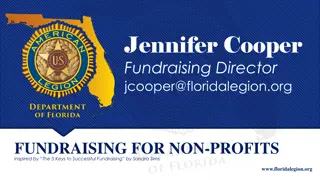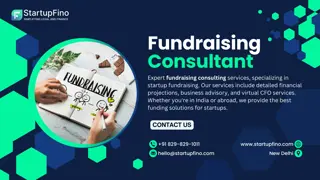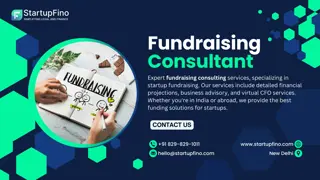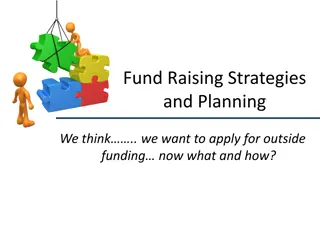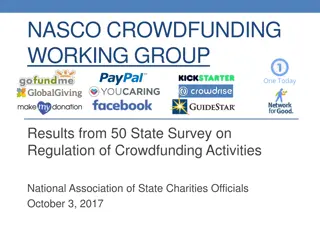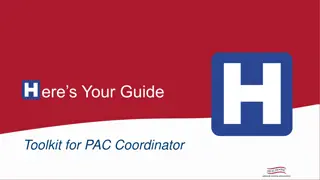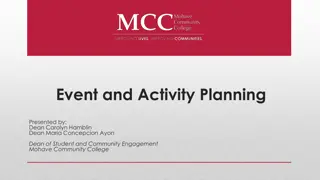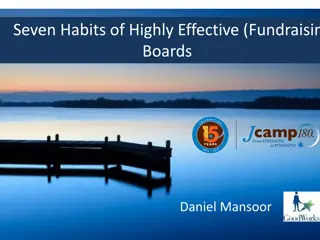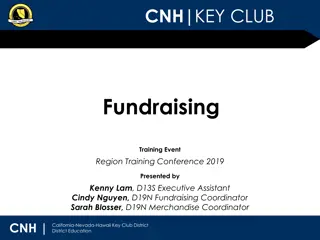
Essential Board Fundraising Responsibilities and Best Practices
Discover the key responsibilities of board members in fundraising, including defining goals, cultivating prospects, attending events, and ensuring ethical practices. Learn why board members should actively participate in fundraising efforts to enhance organizational sustainability and success.
Download Presentation

Please find below an Image/Link to download the presentation.
The content on the website is provided AS IS for your information and personal use only. It may not be sold, licensed, or shared on other websites without obtaining consent from the author. If you encounter any issues during the download, it is possible that the publisher has removed the file from their server.
You are allowed to download the files provided on this website for personal or commercial use, subject to the condition that they are used lawfully. All files are the property of their respective owners.
The content on the website is provided AS IS for your information and personal use only. It may not be sold, licensed, or shared on other websites without obtaining consent from the author.
E N D
Presentation Transcript
Contents I. Fundraising Responsibilities II. Fundraising Facts and Figures III. The Stages of Fundraising IV. Types of Fundraising
Key Roles of the Board Set Organizational Direction Provide Oversight Ensure Necessary Resources
Ensure Necessary Resources Hire capable executive leadership Promote positive public image Ensure the presence of a capable and responsible board Ensure adequate financial resources
The Boards Fundraising Responsibilities Define or clarify the mission Support organizational sustainability Identify strong leadership Approve adequate budgets Plan for the future of the organization Be familiar with the overall fundraising plan Participate in the fundraising process
XYZ Organization Board Fundraising Responsibilities Clearly define annual fundraising goals Delegate responsibilities to meet these goals Create fundraising and donor recognition policies Ensure fundraising methods adhere to ethical standards
Individual Board Member Responsibilities Make personal contributions Identify, evaluate, and cultivate prospects Attend face-to-face solicitations Write appeal letters Organize and attend special events Thank donors
XYZ Organizations Individual Board Member Responsibilities Make an annual personal contribution, a stretch gift Only 40 percent of CEOs surveyed in the 2016 Leading with Intent agreed or strongly agreed that their boards actively participate in fundraising. Raise at least $5,000 from additional donors Attend our special fundraising events Be available to assist with other fundraising efforts
Why Board Members Should Give Demonstrates personal commitment Encourages other funders to give Creates board member ownership
Sample Fundraising Committee Job Description Lead board s participation Work with staff to develop fundraising plan Develop fundraising policies, plans, procedures, and schedules for board Teach board members fundraising skills and techniques Propose minimum board member contributions Solicit contributions from board members Lead the board s effort in identifying, cultivating, and approaching major donors
Sample Development Director Job Description Work with the board and chief executive to develop long-term fundraising strategy Organize and execute fundraising programs Develop relationships with funders Coordinate visits by staff and board members Plan and oversee donor recognition and cultivation Work with staff to design promotional materials for fundraising
Typical Fundraising Duties of the Chief Executive Serve as the organization s representative to potential funders and the community Serve as a contact for donors Ensure compliance with funding sources and regulatory requirements
Why People Give to Nonprofits They feel a connection to the organization Their peers are giving Someone asks them to To make a difference To share their good fortune For recognition To ensure the organization s ability to fulfill its mission in the future For tax reasons To ensure their pet project finds a home
Why People Do Not Give to Nonprofits Solicitation is infrequent or poorly communicated They don t see how their gift would make a difference They never feel wanted or needed They receive no direct, personalized appeal They gave an unacknowledged gift in the past They were not asked to give The timing wasn t right The organization s mission was not compelling
Total Giving in 2015 Total giving: $373.25 billion Individual giving, $264.58 billion, increased 3.8 percent in current dollars over 2014. Foundation giving, $58.46 billion, was 6.5 percent higher than 2014. Individual giving Charitable bequests, $31.76 billion, Foundation giving Charitable bequests Corporate giving increased 2.1 percent over 2014. Corporate giving, $18.45 billion, increased 3.9 percent over 2014 giving. Source: GivingUSA 2016
Donations by Service Area in 2015 Religion at $119.30 billion, 2015 giving increased 2.7 percent in current Total giving: $373.25 billion dollars. Education giving increased to $57.48 billion, 8.9 percent more in current dollars than the 2014 total. Human Services its $45.21 billion total was 4.2 percent higher, in current dollars, than in 2014. To Foundations at an estimated $42.26 billion in 2015, giving declined 3.8 Religion Education percent in current dollars. Human Services Health the $29.81 billion estimated for 2015 giving to this category was 1.3 To Foundations percent higher, in current dollars, than the 2014 estimate. Health Public-Society Benefit Public-Society Benefit the $26.95 billion estimate for 2015 increased 6 Art/Culture/Humanities percent in current dollars over 2014. International Affairs Arts/Culture/Humanities at an estimated $17.07 billion, growth in current Environment/Animals dollars was 7.0 percent in 2015. International Affairs the $15.75 billion estimate for 2015 increased 17.5 percent, in current dollars, from 2014. Environment/Animals the $10.68 billion estimate for 2015 was up 6.2 percent in current dollars over 2014 giving. Source: GivingUSA 2016
Organization XYZs donation in 20xx 3% 7% Individuals Foundations Bequests Corporations 20% 70%
20xx Donations: Where the Money Went 2%2% 12% 12% Program A Program B Program C Overhead Fundraising Other 17% 55%
Stage One: Cultivation Identifying potential donors (prospects) Building relationships with prospects Generating interest in the organization Showing prospects what the organization is all about history, programs, finances, etc.
Stage Two: Solicitation Presenting the organization s case statement Participating in one-on-one solicitation Sending direct mail pieces with personalized notes Making telephone solicitations
Stage Three: Stewardship Thanking donors and letting them know their gift made a difference Maintaining donor relationships Thank you letters Donor recognition activities Invitations to special events Updates from the organization
How Board Members Can Get Involved in Cultivation Make personal contact with prospects Show prospects the facilities Share the history of the organization Share their enthusiasm for the mission of the organization
How XYZ Board Members Can Get Involved in Cultivation
How Board Members Can Get Involved in Solicitation Writing/Reviewing the Case Statement Focus on the results, not the organization s needs Include clear, essential facts Add a connection to the community
How Board Members Can Contribute to Solicitation Making the Ask Notify the prospect you are coming Be enthusiastic and know the prospect s interests in advance Bring a staff member to answer specific questions Research the donor s giving history to determine the appropriate amount to ask for
How XYZ Board Members Can Contribute to Face-to-Face Solicitation
How Board Members Can Get Involved in Stewardship Send letters of appreciation and invitations to special events Maintain relationships with donors Personally thank donors for their contributions Keep donors connected to the organization
How XYZ Board Members Can Get Involved in Stewardship
How to Handle Rejection Offer any additional information needed to change the prospect s mind Don t take it personally Keep the door open
Fundraising Secrets of Success To succeed in fundraising, you must know four things: If you don t ask, you won t receive. The only way to fail is by not trying. 1. The mission of the organization 2. The goals of the organization 3. How to ask 4. How to overcome fears


